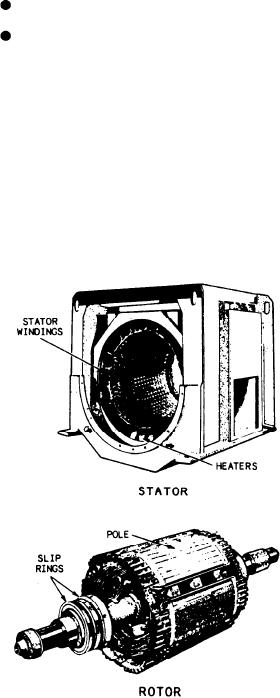
CHAPTER 9
ENGINEERING ELECTRICAL EQUIPMENT
Many of the tasks assigned to you involve the
GENERATORS
operation and maintenance of components of the
60-Hz power distribution system. This may
The two types of ac generators are
involve work on lighting systems, power panels,
rotating field--stationary armature, and
motor controllers, motors, receptacle circuits, and
distribution switchboards (SWBDs). Most of the
rotating armature--stationary field.
60-Hz electrical equipment you work with is found
in the MERs and the CCS. Gas turbine ships also
Only the rotating field--stationary armature--
have Electrician's Mates assigned. They are
is used on gas turbine ships. The size of the
normally responsible for the electrical equipment
generators found on gas turbine ships varies. The
found outside the main machinery spaces.
FFG-7 class ships have 1000-kW ship's service
The information in this chapter provides you
diesel generators (SSDGs). The DD-963 class ships
with basic knowledge of the equipment, pro-
have 2000-kW SSGTGs. The CG-47, DDG-51,
cedures, terminology, and special precautions
and DDG-993 class ships have 2500-kW SSGTGs.
used with 60-Hz equipment. After reading this
The two major components of the rotating
chapter, you should be able to identify 60-Hz
field-stationary armature-are the stator and the
equipment. You should be able to identify the
rotor (fig. 9-1). The stator (armature) is the
different types of generators, motors, SWBDs,
circuit breakers (CBs), motor controllers, and
uninterruptible power supplies (UPSs) found on
gas turbine ships. Also, you should be able to
describe the numbering system used to identify
electrical equipment and cables.
The material presented in this chapter is basic
in nature and explains the principles of operation
of engineering electrical equipment. By studying
this material, you should be able to relate this
information to the specific equipment found on
your ship.
GENERATORS AND MOTORS
Electricity is the most efficient and cheapest
means of distributing energy aboard ships. It is
the primary method used to distribute energy
aboard ship. If electricity were not used, alternate
methods, such as the distribution of hot gases and
rotating energy, would require massive insulated
ducting, heat exchangers, many complex gear-
boxes, and shafts. All these systems would make
control of this energy very difficult.
Generators are the primary means of con-
verting mechanical energy to electrical energy.
Motors are the primary means of converting
electrical energy into mechanical energy.
Figure 9-1.--Generator stator and rotor.
9-1

